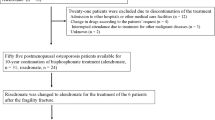Abstract
In ochronotic patients, abnormalities in bone metabolism leading to increased bone loss have been reported. Therefore, we attempted antiresorptive therapy to (almost) partially reverse bone loss in four out of five osteopenic or osteoporotic ochronotic patients, two men and two women, aged 56–82 years. Each patient was treated with a 70-mg tablet of alendronate weekly and 1,000 mg/day of elemental calcium, such as gluconolactate or carbonate, throughout 24 months. Before starting therapy, and after 1 and 2 years of treatment, the bone mineral density (BMD) at the femoral subregions and at the lumbar spine was measured (in grams per square centimeter and as a T score) by dual energy X-ray absorptiometry. A 50-year-old osteopenic ochronotic man refusing the treatment underwent the same checks. The BMD was measured in all patients on the same densitometer by the same operator. The results showed a progressive decrease of the femoral subregion BMD measurements both in the bisphosphonate-treated patients and in the untreated patient. In particular, the percentage differences with respect to the basal values of the total femur BMD measurements ranged from −0.52 to −6.72% in the first year and from −5.29 to −9.05% in the second year. The lumbar spine BMD measurements provided spuriously overestimated results. Moreover, two treated patients and the untreated patient experienced fragility fractures of the femur. The study showed that osteoporosis and fragility fractures are prominent manifestations in the natural history of ochronosis. Matrix microdamage, osteocyte viability, and collagen cross-linking impairment, due to homogentisic acid and to its polymer, might be the processes involved. For this reason, the bisphosphonate therapy was ineffective.



Similar content being viewed by others
References
Pollak MR, Chou YHW, Cerda JJ, Steinmann B, La Du BN, Seidman JG et al (1993) Homozygosity mapping of the gene for alkaptonuria to 3q2. Nat Genet 5:201–204
Phornphutkul C, Introne WJ, Perry MB, Bernardini I, Murphey MD, Fitzpatrick DL et al (2002) Natural history of alkaptonuria. N Engl J Med 347:2111–2121
Ladjouze-Rezig A, Rodriguez de Cordoba S, Aquaron R (2006) Ochronotic rheumatism in Algeria: clinical, radiological, biological and molecular studies—a case study of 14 patients in 11 families. Joint Bone Spine 73:284–292
Gaines JJ (1989) The pathology of alkaptonuric ochronosis. Hum Pathol 20:40–46
Aliberti G, Pulignano I, Schiappoli A, Minisola S, Romagnoli E, Proietta M (2003) Bone metabolism in ochronotic patients. J Intern Med 254:296–300
Fleisch H (2003) Bisphosphonates in osteoporosis. Eur Spine J 12(Suppl 2):S142–S146
Ioannidis JPA, Ralston SH, Bennett ST, Brandi ML, Grinberg D, Karassa FB, GENOMOS Study et al (2004) Differential genetic effects of ESR1 gene polymorphism on osteoporosis outcomes. JAMA 292:2105–2114
Liberman UA, Weiss SR, Broll J, Minnie HW, Quan H, Bell NH et al (1995) Effect of oral alendronate on bone mineral density and the incidence of fractures in potmenopausal osteoporosis. N Engl J Med 333:1437–1443
Black DM, Cummings SR, Karpf DB, Cauley JA, Thompson DE, Nevitt MC, Fracture Intervention Trial Research Group et al (1996) Randomised trial of effect of alendronate on risk of fracture in women with existing vertebral fractures. Lancet 348:1535–1541
Gonnelli S, Cepollaro C, Montagnani A, Bruni D, Caffarelli C, Breschi M et al (2003) Alendronate treatment in men with primary osteoporosis: a three-year longitudinal study. Calcif Tissue Int 73:133–139
Kanis JA, Gluer CC, Committee of Scientific Advisors, International Osteoporosis Foundation (2000) An update on the diagnosis and assessment of osteoporosis with densitometry. Osteoporos Int 11:192–202
WHO Study Group (1994) Assessment of fracture risk and its application to screening for postmenopausal osteoporosis. World Health Organ Tech Rep Ser 843:1–129
Hanson J (1997) Standardization of femur BMD (letter). J Bone Miner Res 12:1316–1317
Cummings SR, Palermo L, Browner W, Marcus R, Wallace R, Pearson J et al (2000) Monitoring osteoporosis therapy with bone densitometry: misleading changes and regression to the mean. Fracture Intervention Trial Research Group. JAMA 283:1318–1321
Tuck SP, Francis RM (2002) Osteoporosis. Postgrad Med J 78:526–532
McClung MR (1996) Current bone mineral density data on bisphosphonates in postmenopausal osteoporosis. Bone 19:195S–198S
Di Franco M, Coari G, Bonucci E (2000) A morphological study of bone and articular cartilage in ochronosis. Virchows Arch 436:74–81
Bonucci E (1984) Matrix vesicles: their role in calcification. In: Linde A (ed) Dentin and dentinogenesis, vol 1. CRC Press, Boca Raton, pp 135–154
Murray JC, Lindberg KA, Pinnell SR (1997) In vitro inhibition of chick embryo lysyl hydroxylase by homogentisic acid. A proposed connective tissue defect in alkaptonuria. J Clin Invest 59:1071–1079
Oxlund H, Barckman M, Ortoft G, Andreassen TT (1995) Reduced concentrations of collagen cross-links are associated with reduced strength of bone. Bone 17:365S–371S (Suppl)
Author information
Authors and Affiliations
Corresponding author
Rights and permissions
About this article
Cite this article
Aliberti, G., Pulignano, I., Pisani, D. et al. Bisphosphonate treatment in ochronotic osteoporotic patients. Clin Rheumatol 26, 729–735 (2007). https://doi.org/10.1007/s10067-006-0390-3
Received:
Revised:
Accepted:
Published:
Issue Date:
DOI: https://doi.org/10.1007/s10067-006-0390-3




